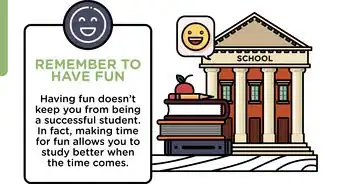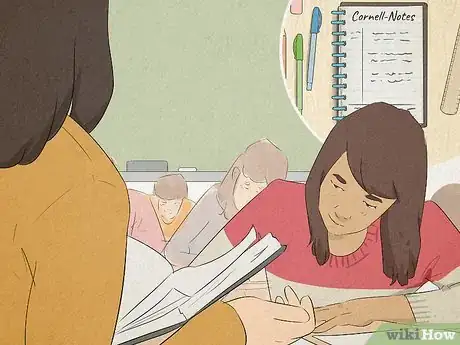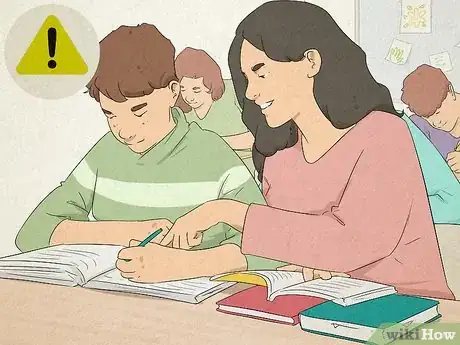This article was co-authored by Jai Flicker and by wikiHow staff writer, Hannah Madden. Jai Flicker is an Academic Tutor and the CEO and Founder of Lifeworks Learning Center, a San Francisco Bay Area-based business focused on providing tutoring, parental support, test preparation, college essay writing help, and psychoeducational evaluations to help students transform their attitude toward learning. Jai has over 20 years of experience in the education management industry. He holds a BA in Philosophy from the University of California, San Diego.
There are 9 references cited in this article, which can be found at the bottom of the page.
This article has been viewed 56,490 times.
Every year, over 1 million children drop out of high school without getting their diploma.[1] X Trustworthy Source Edutopia Educational nonprofit organization focused on encouraging and celebrating classroom innovation Go to source Leaving school without a high school diploma can lead to poorer health, lower-paying jobs, and long-term poverty.[2] X Trustworthy Source Edutopia Educational nonprofit organization focused on encouraging and celebrating classroom innovation Go to source If you’re a teacher or faculty member, there are a few ways you can motivate your students to stay in school and keep them on the path toward education.
Steps
Connect with parents outside of school.
-
Involve parents so they can help motivate their child. If you’re a teacher or faculty member, make appointments with at-risk children for home visits with their parents. Or, host parent-teacher conferences to make an initial connection.[3] X Research source
- You can also give parents access to their children’s online grades. That way, they can keep track of how well their child is doing throughout the year instead of waiting on a report card.
- Not every child has supportive parents, so this might not be possible. If that’s the case, focus on helping your student while they’re in school rather than relying on their parents.
Make connections with your at-risk students.
-
Build a relationship based on trust and honesty. Talk to your students about what they’re going through and really listen to what they have to say. Be open and honest, but give them hope about the future, too.[4] X Research source
- If there are any children in your class who are at-risk, consider meeting with them after school once a week to check in.
- Being honest with your students will help build a relationship much faster than trying to sugarcoat things.
Involve students in extracurricular activities.
-
Push them toward sports or clubs to get them involved with school life. Students who play sports are more likely to go to college and even earn better grades.[5] X Research source
- Some students may not want to do an extracurricular activity (or have the time) and that’s okay too. Let them focus on their studies for now, and bring it up again later on.
- Most extracurricular activities require passing grades to participate, which is another good motivation to stay in school and make good grades.
Pair students with advisors.
-
Have academic advisors check in with students throughout the school year. You can pair individual students or groups of students and have them meet with their advisors on a weekly or monthly basis.[6] X Trustworthy Source Edutopia Educational nonprofit organization focused on encouraging and celebrating classroom innovation Go to source
- If you don’t have that many advisors, you can save appointments for children who are most at-risk of failing or dropping out.
- Academic advisors can also help students plan for their academic future, like applying for colleges or trade schools.
Connect lessons to the real world.
-
Motivate your students by emphasizing the importance of education. If you’re a teacher, try to make connections between your lessons and the real world whenever you can.[7] X Research source
- For example, you could find internships in your community and give children school credit for attending them once a week.
- If you’re a science teacher, take your students on field trips to natural areas around the school as you talk about botany or climate change.
Challenge children who may be bored.
-
Keep an eye on advanced children who might need more stimulation. Steer them toward honors or AP classes so they’re interested in what they’re studying.[8] X Research source
- Some kids might even be so advanced that they can take college classes while still in high school. Many community colleges have programs for younger students to start getting college credit even before they graduate.
Get flexible with the school schedule.
-
Make school more accessible for children with other responsibilities. If you can, try to host classes at night or on the weekends to make up for lessons lost.[9] X Research source
- Night classes are very helpful for students who might have to work during the day to help support their families.
Reduce the cost of education.
-
Try to provide things like textbooks and materials for free. These small costs can add up, and if students don’t have the money, they may not be able to stay in school.[10] X Research source
- For example, you could have your students rent textbooks from the library instead of buying them.
- Or, you could ask your department to provide equipment that you need for class instead of asking your students to buy it.
Offer mental health support.
-
Point children toward people that can help them if they’re struggling. Steer them toward free or cheap resources, like school counselors, online counseling, and self-care.[11] X Trustworthy Source Edutopia Educational nonprofit organization focused on encouraging and celebrating classroom innovation Go to source
- If your school doesn’t have a mental health program, talk to a nearby community college. They may be able to provide resources on a sliding scale for students in need.
Teach children about career and salary realties.
-
Motivate your students by telling them how education leads to a career. Talk to your students about degrees and how they often correlate with well-paying jobs and professions.[12] X Research source
- Try to talk about other paths besides a traditional 4-year college. Trade schools and 2-year programs are becoming more and more popular, and they can lead to some great professions.
Try a mentoring or tutor program.
-
Give kids emotional and academic support with a mentor or tutor. You can find a mentor program through your local community center, like the Boys and Girls Club, or you can make one of your own in your school.[13] X Research source
- Older students can also be great tutors. You could try pairing 9th graders with 12th graders for help in English, math, or science.
Provide community resources.
-
Occupy a student's free time so they don’t fall in with the wrong crowd. Tell your students about volunteer programs, community centers, classes at community college, and faith-based institutions.[14] X Trustworthy Source American Psychological Association Leading scientific and professional organization of licensed psychologists Go to source
- You don’t have to force your students to participate in any of these programs, and some may not want to. Just provide the resources for students who do want it just in case.
Teach children good study habits for college.
-
Give them the skills to succeed in college while they’re still in school. Try to teach your students how to study effectively for tests so they don’t get frustrated or fail out of college.[15] X Trustworthy Source Edutopia Educational nonprofit organization focused on encouraging and celebrating classroom innovation Go to source
- The Cornell notes strategy is a great one to teach students for effective studying.
Pay special attention to at-risk students.
-
Watch out for warning signs that a child may be close to dropping out. If students are failing English or math, are absent for more than 20 school days in 1 year, or earn 2 or fewer credits throughout the year, they’re more likely to drop out. Reach out to these children and connect them with a mentor or advisor to talk about next steps.[16] X Trustworthy Source Edutopia Educational nonprofit organization focused on encouraging and celebrating classroom innovation Go to source
- Many students who fail classes early on have a hard time catching up in time for graduation. You could try an accelerated credit program to get these students the courses they need to graduate from high school.
Expert Q&A
-
QuestionHow do you customize your teaching approach for different students?
 Jai FlickerJai Flicker is an Academic Tutor and the CEO and Founder of Lifeworks Learning Center, a San Francisco Bay Area-based business focused on providing tutoring, parental support, test preparation, college essay writing help, and psychoeducational evaluations to help students transform their attitude toward learning. Jai has over 20 years of experience in the education management industry. He holds a BA in Philosophy from the University of California, San Diego.
Jai FlickerJai Flicker is an Academic Tutor and the CEO and Founder of Lifeworks Learning Center, a San Francisco Bay Area-based business focused on providing tutoring, parental support, test preparation, college essay writing help, and psychoeducational evaluations to help students transform their attitude toward learning. Jai has over 20 years of experience in the education management industry. He holds a BA in Philosophy from the University of California, San Diego.
Academic Tutor Stay really attuned to each student that you work with. Focus on challenging your students at the right level—not too easy, and not too difficult. As you teach, pay close attention to your students, and whether they seem especially bored or frustrated. If the student seems really bored, you might make the lesson more tricky. If the student is frustrated, you might make their workload a little less difficult.
Stay really attuned to each student that you work with. Focus on challenging your students at the right level—not too easy, and not too difficult. As you teach, pay close attention to your students, and whether they seem especially bored or frustrated. If the student seems really bored, you might make the lesson more tricky. If the student is frustrated, you might make their workload a little less difficult.
You Might Also Like














References
- ↑ https://www.edutopia.org/student-dropout-retention-strategies
- ↑ https://www.edutopia.org/student-dropout-retention-strategies
- ↑ http://www.adlit.org/article/20797/
- ↑ https://theartofeducation.edu/2018/09/10/5-ways-to-build-relationships-with-at-risk-students/
- ↑ https://www.aspenprojectplay.org/youth-sports-facts/benefits
- ↑ https://www.edutopia.org/student-dropout-retention-strategies
- ↑ https://www.expandinglearning.org/expandingminds/article/proven-solution-dropout-prevention-expanded-learning-opportunities
- ↑ https://dropoutprevention.org/effective-strategies/individualized-instruction/
- ↑ https://www.accreditedschoolsonline.org/resources/preventing-students-dropping-out/
- ↑ http://www.adlit.org/article/20797/
- ↑ https://www.edutopia.org/student-dropout-retention-strategies
- ↑ https://www.accreditedschoolsonline.org/resources/preventing-students-dropping-out/
- ↑ https://dropoutprevention.org/effective-strategies/mentoring-tutoring/
- ↑ https://www.apa.org/monitor/2012/02/at-risk-students
- ↑ https://www.edutopia.org/student-dropout-retention-strategies
- ↑ https://www.edutopia.org/student-dropout-retention-strategies
About This Article



























































